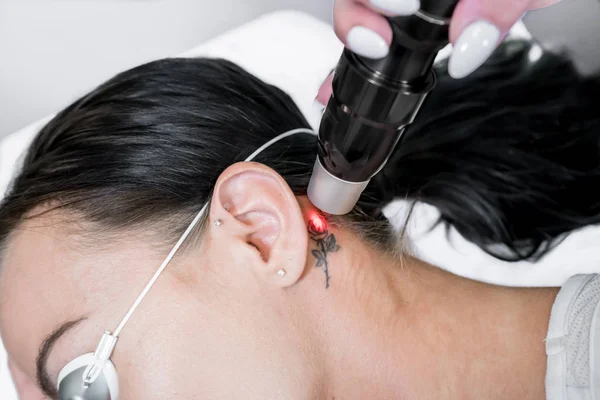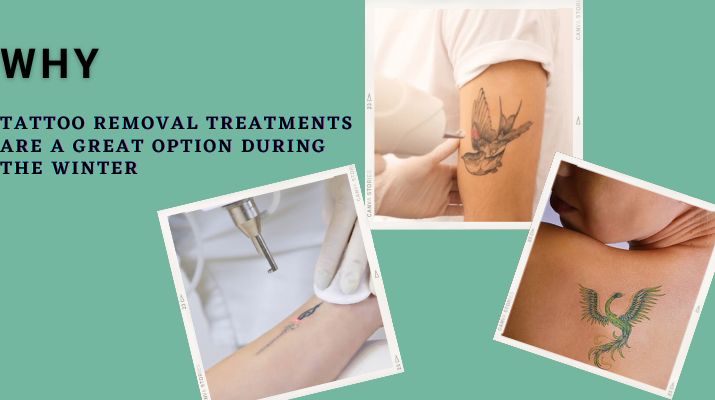Tattoo Removal
Tattoos are a popular form of self-expression, but sometimes they outlive their purpose, and people desire to have them removed. If you’re looking for a way to eliminate unwanted tattoos, consider getting a tattoo removal procedure during the winter months. The colder weather makes it an ideal time for skin care treatments, but there are also benefits to having a tattoo removal procedure done in the winter, such as reduced pain and improved results.
So, if you’re ready to say goodbye to your tattoos, winter might be the best time to start your journey to a tattoo-free life. In this blog, we’ll dive deeper into this skin care treatment and explore the benefits of doing it during the winter months.
Why Winter Is the Best Time for Tattoo Removal Treatment
There are several reasons dermatologists and tattoo removal specialists recommend winter as a good time for tattoo removal. The procedure uses a laser to break down the ink pigments in the skin, and colder weather can reduce the sensation of heat from the laser as well as minimize overall discomfort. This makes the process less painful and more comfortable for the patient.
Another reason why winter is the best time for tattoo removal treatments is because the skin is less exposed to the sun during this time of year. Sun exposure can cause skin damage and slow the healing process after tattoo removal. But by having the treatment performed during winter, you can avoid excessive sun exposure and allow your skin to heal properly.
Finally, with the holiday season approaching, many people want to save money and prioritize their spending. As such, winter is the ideal time to consider getting a tattoo removal procedure, as it may be more affordable during this time.
What Are the Best Types of Tattoo Removal?
When it comes to tattoo removal, there are several treatment options available. These procedures vary in terms of approach, cost, and results. These treatments include:
1. Laser tattoo removal
Laser tattoo removal is one of the most popular and effective methods of removing unwanted tattoos. It works by using laser energy to break down the ink pigments in the skin, which are then naturally absorbed and eliminated by the body. This procedure is suitable for many tattoo colors and skin types and can be used to remove both small and large tattoos.
2. Dermabrasion
This procedure involves using a rotary device to sand down the top layer of skin, effectively removing the tattoo. Dermabrasion is a more invasive procedure than laser tattoo removal and is typically used to remove smaller or lighten larger tattoos before undergoing laser treatment.
3. Chemical peels
This procedure involves applying a chemical solution to the skin to remove the outer layer of skin and effectively fade the tattoo. Chemical peels are suitable for small tattoos and can be used with laser tattoo removal to enhance the results.
4. Surgical excision
This procedure involves cutting out the tattooed skin and stitching the edges together. Surgical excision is typically used to remove small tattoos and is more invasive than laser tattoo removal or dermabrasion.
5. Tattoo removal creams
These are topical creams that claim to fade tattoos over time. However, they are not as effective as the other procedures mentioned above, and results can vary greatly depending on the type and color of the tattoo.
As with all skin care treatments, you’ll want to work closely with your tattoo removal specialist or dermatologist to determine the best procedure for your needs.

The Process of Laser Tattoo Removal
Laser tattoo removal is a popular treatment option for a wide range of tattoos and skin types. Let’s break the procedure down into its parts:
1. Consultation
The first step of any skin care treatment will be to schedule a consultation with your tattoo removal specialist. During this consultation, the specialist will evaluate your tattoo and skin type and discuss the best course of action based on these factors.
2. Numbing
Before the laser tattoo removal procedure, the affected area will be numbed with a local anesthetic to minimize pain and discomfort.
3. Treatment
Your tattoo removal specialist will then use a laser device to deliver pulses of light energy to the tattoo. This laser breaks down the ink pigment beneath your skin, allowing it to be absorbed and removed naturally by the body.
4. Aftercare
After the procedure, the treated area will be covered with a bandage, and you will be instructed to follow specific aftercare instructions to ensure proper healing.
5. Follow-up
Typically, several treatment sessions are needed to fully remove a tattoo, and the number of sessions required will depend on the size and color of the tattoo. Your tattoo removal specialist will schedule follow-up appointments as needed for the best results.
In all, laser tattoo removal is a safe and effective procedure for many skin types and tattoos. Aftercare needs are minimal, with the worst side effects including redness, swelling, and general discomfort that typically resolves within a week.
Frequently Asked Questions About Tattoo Removal
If you’re interested in tattoo removal, you’ve probably developed several questions about the procedure. And that’s great! To help make sense of these procedures, we’ve put together some commonly asked questions about tattoo removal.
1. Does tattoo removal hurt?
Yes, in some cases, tattoo removal can be painful. The laser energy applied to the skin causes discomfort, but this pain can vary depending on the person’s tolerance and the size of the tattoo being removed. Anesthetics are often used to reduce discomfort, but this may also depend on the type of laser and the individual practitioner’s preference.
2. Who is a candidate for tattoo removal?
Generally, anyone with a tattoo they no longer want can be a candidate for tattoo removal. However, some factors such as age, skin color, and the tattoo’s type and color may affect the removal’s success. Therefore, it is best to consult with a qualified laser specialist who can evaluate your individual case and provide you with an informed recommendation.
3. Why does it take more than one session to remove a tattoo with laser tattoo removal?
Laser tattoo removal works by breaking down the ink particles in the tattoo into smaller pieces, which the body can then absorb. It typically takes multiple sessions to completely remove the tattoo because not all of the ink particles can be removed in a single treatment. The number of sessions required depends on various factors, such as the size and color of the tattoo, the type of ink used, and the location of the tattoo on the body.
4. Will laser tattoo removal completely remove my tattoo?
In most cases, laser tattoo removal can significantly lighten or remove a tattoo, but it is not always possible to remove it altogether. The degree of removal depends on various factors, such as the size and color of the tattoo, the type of ink used, and the location of the tattoo on the body. As such, it is important to have realistic expectations about the outcome of the removal process and to consult with a qualified laser specialist for a personalized assessment.
5. Can I remove a tattoo at home?
No, it is not recommended to attempt tattoo removal at home! The process of laser tattoo removal involves using powerful lasers and should only be performed by a trained professional in a medical setting. Attempting to remove a tattoo at home can result in severe skin damage and other complications.
6. How long does tattoo removal take?
The length of the tattoo removal process depends on several factors, such as the size and color of the tattoo, the type of ink used, and the number of sessions required. The average time between sessions is 4-8 weeks, and it can take several months to several years to entirely remove a tattoo, depending on these factors.
7. How do I find a doctor to remove my tattoo?
You can start by searching online for a dermatologist, plastic surgeon, or laser specialist specializing in tattoo removal. You can also ask for recommendations from friends or family members who have undergone tattoo removal or check with local medical societies for a list of qualified practitioners. It is crucial to choose a qualified professional with experience in tattoo removal who can provide you with the best results and care.
8. How do I take care of my skin after tattoo removal?
It is important to follow the aftercare instructions provided by your laser specialist, which may include avoiding sun exposure, applying petroleum jelly to the treated area, and avoiding any activities that can irritate the skin. You should also keep the treated area clean and dry and avoid picking at any scabs that may form. You should contact your laser specialist immediately if you experience any unusual symptoms, such as severe pain, excessive redness, or swelling.
Need Professional Help with Tattoo Removal? Winston Salem Dermatology Can Help!
If you’re searching for safe and effective tattoo removal procedures and cosmetic skin treatments, Winston Salem Dermatology is your premier choice. In addition to tattoo removal procedures, we offer a full range of skin care treatments for conditions such as rosacea, acne, eczema, and more.
With our experienced and knowledgeable staff, state-of-the-art equipment, and commitment to providing top-notch care, Winston Salem Dermatology is a resource you can rely on to help you achieve and maintain healthy, youthful-looking skin, no matter your age or condition.
So, if you’re ready to take the first steps in removing unwanted or unsightly tattoos, call Winston Salem Dermatology at (336) 774-8636! We’ll be happy to help you schedule a consultation and find the right treatment plan for your needs!


